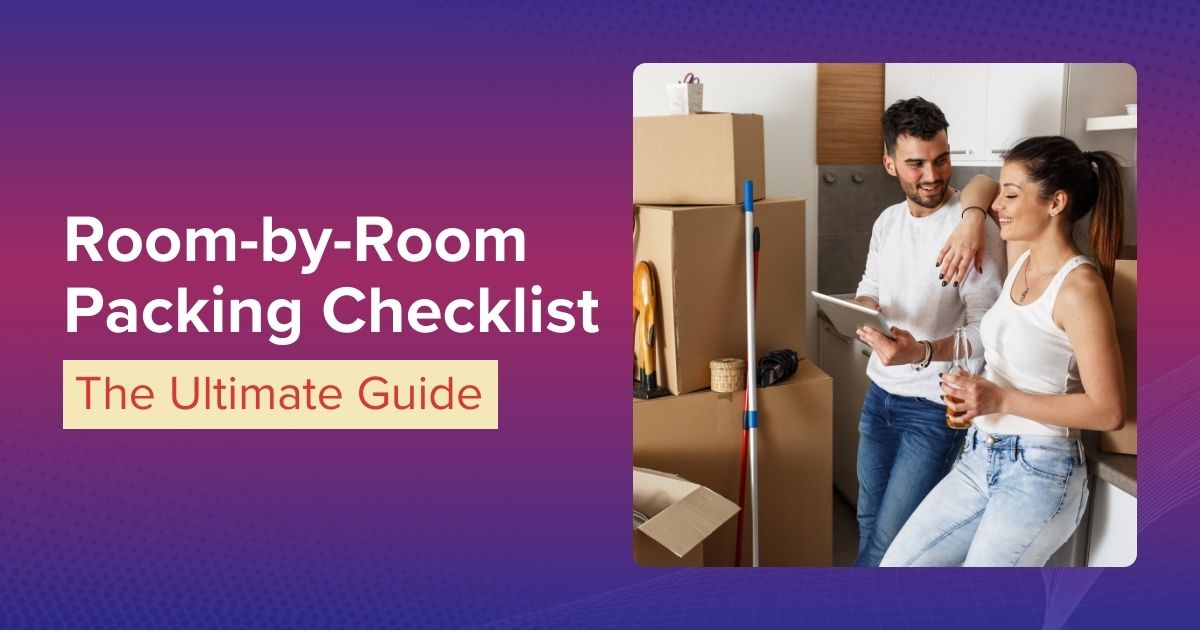Do you know what rooms to include in a room-by-room packing checklist?
With your moving checklist completed and your moving budget in place, now is the time to turn your attention to packing. A room-by-room packing checklist will help you stay organized throughout your move.
Whether you’re packing on your own or have someone helping you with pre-move packing, having a packing checklist will ensure that nothing is missed or incorrectly parceled.
Just like a room-by-room moving checklist, you’ll want to keep your packing checklist in a digital spreadsheet (such as Excel or Google Sheets) or on a home inventory app. These digital formats are portable, easy to edit, and more manageable than paper lists.
Click the link below for the spreadsheet. Make sure you create a copy of this one and then make edits.
ROOM BY ROOM PACKING CHECKLIST
The following sections break down the nine essential rooms to pack in a home, including sample lists you can use.
1. Living Room
Let’s start in the living room, which is usually a mix of furniture, electronics, lighting and decorative elements.
Some things to include in your living room packing list:
- Electronics (TV, speakers, gaming consoles)
- Furniture (couch, coffee table, shelves)
- Decorative items (rugs, paintings, vases)
- Books and magazines
If you use part of your living room as an office, kid’s playroom or pet palace, you can include those items on this list. To accommodate these items, create a sublist nested under this one, or treat it as its own room; whatever makes the most sense to you.
Done?
That was a good warm-up for the rest of the rooms in the house. Buckle up and let’s move on to your bedroom packing checklist.
2. Bedroom
Continue your room-by-room packing checklist with your bedroom, followed by any other bedrooms you may have.
If you have different types of bedrooms, like a master bedroom and a kids’ bedroom, you have options. You can create separate sections for each or make subheadings under a larger “Bedroom” heading. Choose the approach that suits you best.
Some things to include in your bedroom packing list:
- Clothing (clothes, shoes, accessories)
- Bedding (sheets, pillows, comforter)
- Furniture (bed frame, nightstands, dresser)
- Personal items (jewelry, cosmetics)
The bedroom is probably where you’re going to use the biggest variety of packing materials. You need wardrobe boxes for clothing, regular boxes for folded items and books, furniture protection items like blankets, foam corners, cling wrap, packing tapes, mattress covers, etc.
Make notes of what packing materials you may need for each type of room so you order the right packing supplies in time.
3. Kitchen
Although it may be the most daunting room on your checklist due to the sheer number and variety of items, you do eventually need a kitchen packing plan.
In the kitchen, it will be handy to add details about how early items can be packed. Lesser-used tools and appliances can be packed early and the stuff you use every day has to be accessible to you until the very last meal.
Make a note to leave cleaning products until the end too because you will want to clean before you depart and keep those items handy for cleaning when you arrive at your new home.
Some things to include in your kitchen packing list:
- Cookware (pots, pans, utensils)
- Appliances (microwave, toaster, blender)
- Dishes and glassware
- Food items (non-perishables)
Remember that non-perishable foods, including herbs and spices, can be packed for transportation in the moving truck.
Anything perishable must be either transported separately by you in a climate-controlled thermal bag, or it must be thrown out. Write something like “move myself” or “toss” beside these items so you don’t have to make these decisions hastily on the moving day.
4. Bathroom
Create subsections for each bathroom in your home and start listing every item in each.
It may be tempting to pack similar items from two or more bathrooms in boxes together but this will just make unpacking a nightmarishly long process. Keep it simple and keep the bathroom packing lists separate.
Some things to include in your bathroom packing list:
- Toiletries (shampoo, soap, toothpaste)
- Towels and washcloths
- Medicine and first-aid kit
- Cleaning supplies
Before you move on to the next room, make a note of some necessities to pack separately such as toothbrush, toothpaste, and daily medications. These things you can carry on with yourself during the move. That way, you have the things you need if you get separated from your belongings or can’t find your toiletries box immediately after the move finishes.
5. Home Office
Whether your office is its own room with a door on it, or a dedicated space in your basement, living room, bedroom, or attic, make sure it gets its separate section on this packing checklist.
Some things to include in your home office packing list:
- Electronics (computer, printer, scanner)
- Office supplies (paper, pens, folders)
- Important documents (passport, contracts, certificates)
- Furniture (desk, chair, filing cabinet)
When packing, consider wrapping items that could benefit from anti-static protection, such as laptops, computer monitors, and tablets.
You’re on a roll and should be more than halfway through by now depending on how many rooms your home has in total.
6. Nursery and Kid’s Play Room
In cases where your children have their own nursery or kid’s playroom, make sure it’s covered on your room-by-room packing checklist.
One packing hack is to use existing trunks and toy bins to move toys and games instead of packing them separately, as long as it’s not too heavy to move. Just make sure toy boxes and costume trunks are sealed so they don’t pop open while your professional movers are handling them.
As for art supplies, make sure anything liquid (paint, glue) is secured in a vessel that will contain any leaks that may occur during the move.
Some sub-sections to include in the nursery and kid’s play room packing list:
- Children’s clothes
- Toys and games
- Art supplies
- Desk, chairs and other furniture
Once you’re finished with the kids’ stuff, it’s time to move on to the dining room if you have one.
7. Dining Room
Naturally, we must carefully pack the dining room and all of its “good china” and furniture which is typically more expensive than the everyday stuff in the kitchen.
Include notes on packing materials you might need to protect the corners of mirrors, the legs of dining room chairs, cabinets, silverware and dishware.
Some things to include in your dining room packing list:
- Dining set (table, chairs)
- Tableware (plates, glasses, silverware)
- Decorations (tablecloth, centerpieces)
- Bar items (wine glasses, cocktail shaker)
Unless you have a sprawling estate with multiple buildings on it, you should at this point be in the home stretch of making your room-by-room packing checklist.
8. Garage and Storage Space
Let’s not forget the more peripheral spaces of the house: the garage and storage space. This includes attics and sheds. If you have more than one of these storage areas, either create a separate section for each or make subsections for each under a “Storage Spaces” heading.
There are also some things professional movers won’t move that tend to be stored in garages, sheds and storage spaces away from our living spaces. Make sure you make note of the items that will be packed for the truck, and what will be moved separately.
Some things to include in your garage and storage space packing list:
- Tools (hammer, screwdriver, wrench)
- Outdoor equipment (lawn mower, gardening tools)
- Seasonal items (holiday decorations, camping gear)
- Storage boxes and bins
- Bikes, ice skates, balls and other sporting goods
You’re nearly through making your room-by-room packing checklist. Are there any rooms we haven’t yet covered? We get to all of the “miscellaneous” rooms next.
9. Miscellaneous
Your home is as unique as you are and you could have rooms that we haven’t yet covered.
So, what do you have?
A wine cellar full of vintage, collectible wines!
A “man cave” full of memorabilia, a fully-stocked bar, furniture, and electronics!
Maybe your kids have their own music room, or maybe your home has a larger than typical laundry room that deserves its own list. Whatever it is, make sure it has its own space on the overall packing checklist.
Some of the miscellaneous spaces to cover include:
- Pets (pet food, toys, bedding)
- Bar room, wine cellar (bottles, racks, accessories)
- Laundry room (soaps, appliances, hangers)
- Special collections (artwork, antiques, memorabilia)
- Woodworking shop (wood, tools, shop vac)
- Music room (instruments, books, music stands, amplifiers)
- Sunroom (solarium, conservatory
- Library (books, furniture, lighting)
- Outdoor spaces (BBQ, patio furniture, planters)
- Home gym (Heavy equipment, yoga mats, weights)
Keep your room-by-room packing checklist updated and get rid of belongings in the days leading up to your moving day.
Conclusion: A Room-by-Room Packing Checklist is Crucial for Stress-Free Move
Ultimately, a room-by-room packing checklist is crucial for a hassle-free move but how you format it and how detailed you get is up to you. An elegant and minimal checklist can be just as effective as one that is exhaustively detailed.
Remember to label boxes clearly with their contents and the room to which they belong. Creating an inventory list for each box is an extra step toward making unpacking easier.
Make sure to tailor the checklist to your specific home and needs, and don’t forget to account for any unique or specialty rooms or spaces you have. Happy packing!


















